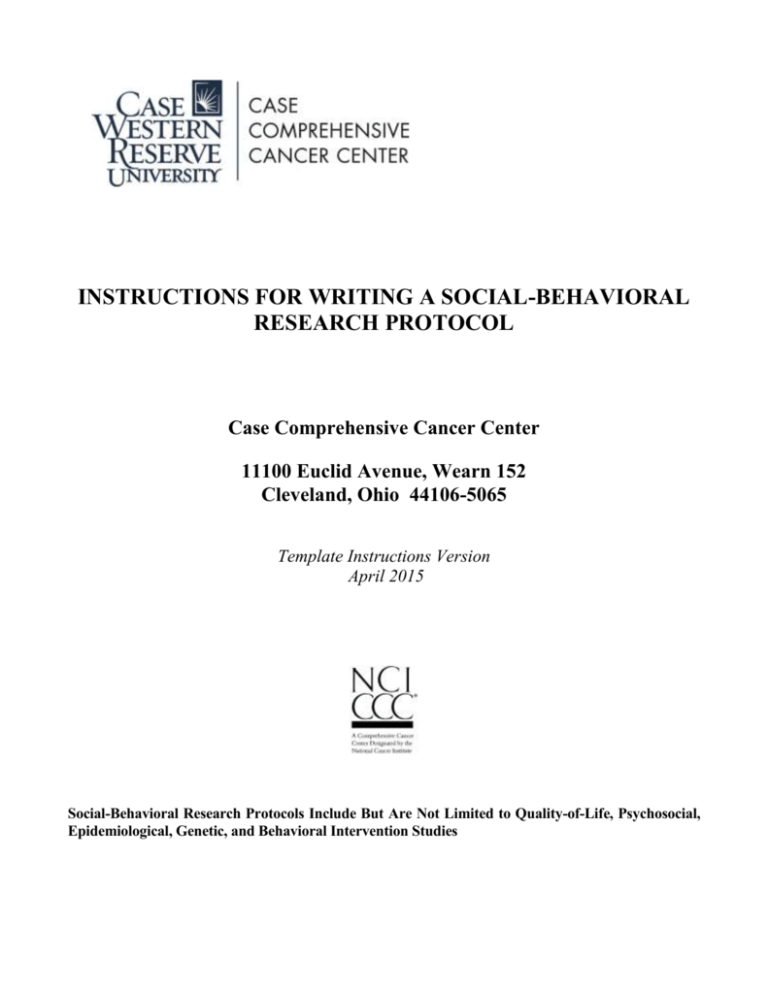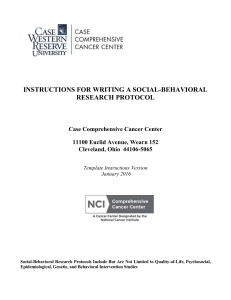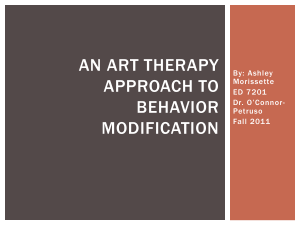outline for writing a non-treatment research protocol
advertisement

INSTRUCTIONS FOR WRITING A SOCIAL-BEHAVIORAL RESEARCH PROTOCOL Case Comprehensive Cancer Center 11100 Euclid Avenue, Wearn 152 Cleveland, Ohio 44106-5065 Template Instructions Version April 2015 Social-Behavioral Research Protocols Include But Are Not Limited to Quality-of-Life, Psychosocial, Epidemiological, Genetic, and Behavioral Intervention Studies TABLE OF CONTENTS ACKNOWLEDGEMENT .................................................................................................................... 3 INTRODUCTION ................................................................................................................................. 3 PART A: SUBMISSION INSTRUCTIONS...................................................................................... 4 General Guidelines/Checklist...................................................................................................... 4 Protocol Format ............................................................................................................................ 5 PART B: BODY OF PROTOCOL ...................................................................................................... 5 Table of Contents.......................................................................................................................... 5 Introduction................................................................................................................................... 6 Objectives ..................................................................................................................................... 6 Research Subject Selection .......................................................................................................... 6 Research Subject Entry ................................................................................................................ 6 Study Design and Methods .......................................................................................................... 7 Statistical Analysis ....................................................................................................................... 9 References..................................................................................................................................... 9 Appendices ................................................................................................................................... 9 ACKNOWLEDGEMENT This document is based on and was adapted with permission from Instructions for Writing a Quality-ofLife Research Protocol (April 1998) and Instructions for Writing a Social-Behavioral Research Protocol (December 2009) of Dana Farber/Harvard Cancer Center. CASE XXXX Version Date 2 INTRODUCTION Instructions in this document are intended to guide investigators in preparing social-behavioral research protocols. Investigator-written protocols have to follow the provided format. Studies written by cooperative groups, agencies or industry sponsors must contain the information described in these instructions; however, they do not have to be reformatted to match section for section. Any missing and/or additional parts may be added at the end of the protocol. NOTE Protocols written and submitted in a grant format will not be accepted for review. Any questions about the instructions, the protocol submission and review process and Protocol Review and Monitoring Committee (PRMC) meetings and submission deadlines should be addressed to: April Firstencel Protocol Review & Monitoring Systems Manager Case Comprehensive Cancer Center Tel: (216) 286-2294; Fax: (216) 201-4043; Email: april.firstencel@case.edu Social-Behavioral Research and Quality-of-Life Protocols The PRMC is responsible for the review of protocols involving quality-of-life and other behavioral research which includes, but is not limited to the following: questionnaires, interviews, observation and behavioral interventions, and epidemiological and genetic studies. Subsequently, protocols reviewed by the PRMC are reviewed by the Institutional review Board (IRB). Protocols Containing Social-Behavioral Research and Quality-of-Life Components as Secondary or Tertiary Objectives Protocols containing social-behavioral research and quality-of-life components such as questionnaires and surveys as secondary or tertiary objectives are also reviewed by the PRMC and, subsequently, by the IRB. The social-behavioral research and quality-of-life components of these protocols must address issues listed in the General Guidelines/Checklist section (see part A below) of the Instructions for Writing a Social-Behavioral Research Protocol. Part A: Submission Instructions This part provides a list of materials that must be submitted with a new protocol and gives general instructions for preparing a social-behavioral research protocol. Please remove all instructions from final protocol prior to submission to PRMC. Part B: Body of Protocol This part is formatted to correspond directly with the numbered sections of a proposed protocol. Sections provide information and instructions for writing of the corresponding sections in the actual protocol. The protocol should be formatted using the major section numbers such as 1.0, 2.0, etc.; subheadings (1.1, 2.12, etc.) may be used where appropriate. Please remove all instructions from final protocol prior to submission to PRMC. CASE XXXX Version Date 3 PART A: SUBMISSION INSTRUCTIONS GENERAL GUIDELINES/CHECKLIST Social-behavioral research protocols and sections from protocols containing social-behavioral research and/or quality-of-life components should adhere to the guidelines specified below. These guidelines may be used by investigators as a checklist to ensure that all necessary aspects of a study are included in the written protocol. In addition, these specifications are followed by the PRMC members during the review process. Methodology 1. The Social/Behavioral Science component should be listed as one of the primary, secondary, or exploratory goals. 2. Selection of instruments should be justified both from scientific and psychometric perspectives. A description of the instrument validation, and experience in previous studies should be included. 3. Timing of the instrument administration should be discussed. 4. The analytic plan should be clearly outlined and it should contain the following information: Scoring of instruments/interviews; Sample size/power considerations; Analysis plan; Handling missing data Logistics 5. All survey instruments, interview scripts, and any planned correspondence with subjects or their physicians should be attached as appendices. 6. The protocol has to include information on how Social/Behavioral Science data will be handled and disseminated (e.g. confidentiality issues, information sharing with treating physicians, information inclusion in medical charts). This information should also be included in the consent form. 7. The protocol should address how detection of serious concerns discovered during quality of life testing, such as, for example, signs of depression, suicidal thoughts, signs of potential abuse, will be handled (e.g. access to support staff, availability of counseling). 8. The consent form has to adequately address Social/Behavioral Science and/or quality-of-life testing. 9. All regulatory information and accrual (i.e. number of patients enrolled, questionnaires received, records processed, etc.) are required to be entered into the OnCore™ Clinical Trials Management System (OnCore database). Please refer to the PRMC Application and/or contact your regulatory coordinator or e-mail your question(s) to oncore-registration@case.edu for more information. PROTOCOL FORMAT The following formatting guidelines should be used for the Page Setup: Font and Size: Times New Roman, 12 or a similar font and point size; Margins: left and right: minimum 0.5 inch; Margins: top and bottom: minimum 0.4 inch for the header and footer; Header: the protocol number or short title, if the protocol number has not been assigned, and the date that the protocol was last changed should be included on each page; Pagination: bottom of page, centered. CASE XXXX Version Date 4 PART B: BODY OF PROTOCOL TITLE PAGE Study Number: (assigned by PRMC) Study Title: Principal Investigator: (List PI’s name, degree, position, affiliation, address, telephone, e-mail) Co-Investigators: (List PI’s name, degree, position, affiliation, address, telephone, e-mail) Research Personnel: (List PI’s name, degree, position, affiliation, address, telephone, e-mail) Study Site(s): (List all sites involved) Protocol Version: (1.0) Protocol Date: (month/day/year) Sponsor: Case Comprehensive Cancer Center Funding Sponsor: CASE XXXX Version Date 5 TABLE OF CONTENTS A Table of Contents must be included with the protocol. The Table of Contents presented below outlines the format required for all Social-Behavioral research and quality-of-life protocols submitted to the PRMC. Protocols written by cooperative groups, agencies or commercial sponsors have to be accompanied by a cover letter indicating which sections of the protocol fulfill the requirements of the sections in the Case CCC format, and any missing and/or additional sections may be added at the end of the protocol. TABLE OF CONTENTS 1.0 INTRODUCTION .......................................................................................................................... 1.1 Overview................................................................................................................................... 1.2 Background and Rationale ....................................................................................................... 2.0 OBJECTIVES................................................................................................................................. 3.0 RESEARCH SUBJECT SELECTION.......................................................................................... 4.0 RESEARCH SUBJECT ENTRY .................................................................................................. 5.0 STUDY DESIGN AND METHODS ............................................................................................ 5.1 Design/Study Type ................................................................................................................... 5.2 Selection of Instruments ........................................................................................................... 5.3 Description of Intervention ...................................................................................................... 5.4 Data Collection ......................................................................................................................... 5.5 Description of Study Process ................................................................................................... 5.6 Adverse Reactions and Their Management ............................................................................. 6.0 STATISTICAL ANALYSIS ......................................................................................................... 7.0 REFERENCES ............................................................................................................................... 8.0 APPENDICES ................................................................................................................................ CASE XXXX Version Date 6 1.0 INTRODUCTION 1.1 Overview The first paragraph should summarize the proposed study. It should describe the study purpose and give answers to the following questions: 1) Does the study seek to test a pilot hypothesis for a future project? 2) Does the study seek to validate an instrument? 3) Will any future interventions be designed based on the findings? If applicable, this paragraph should also mention the sponsor and funding information. 1.2 Background and Rationale This section should give the background and rationale for initiating the study. Findings from a literature search must be outlined including appropriate detailed references to earlier studies and data. Results from any pilot studies conducted, if applicable, should be included. If necessary, additional references to supporting data or additional information may be included in an appendix. This section should contain comprehensive information to ensure that the project can be adequately reviewed. 2.0 OBJECTIVES The objectives section should give a concise statement of the research hypotheses. This section should also state whether the protocol is a feasibility or descriptive study. Example: To test an instrument... To describe... The study design must allow the investigator to answer the research objectives and the statistical section will have to clearly outline how the data will be evaluated in relation to each of these objectives. 3.0 RESEARCH SUBJECT SELECTION AND ELIGIBILITY This section should give a detailed description of research subject population being evaluated by the protocol and address eligibility requirements. Additional consideration should be given to the following factors: 1) patient disease group and response to treatment; 2) participation in treatment protocols; and 3) prior therapy received and determination of a risk group. Any gender, employment, geographical, language, or other requirements must be also clearly stated and justified. NOTE A participant's eligibility cannot be affected by his/her refusal to answer individual questions on any instrument. The participant’s ability to obtain treatment must likewise not be affected by refusal to participate in the Social/Behavioral Science portion of the study. However, the ability to participate in the treatment segments of protocols with Social/Behavioral Science components may be affected by the refusal to take part in the Social/Behavioral Science portion if: 1) it is a commercially sponsored study which mandates Social/Behavioral Science data collection, and/or 2) Social/Behavioral Science is the primary endpoint of the trial. Subjects have to be fully apprised about these facts and about any other conditions which may affect their ability to receive treatment. 4.0 RESEARCH SUBJECT ENTRY CASE XXXX Version Date 7 This section should describe procedures for subject recruitment, registration and/or randomization. The means of obtaining consent, implied consent issues, use of opt-out cards, etc. should be fully described. If the investigator wishes to request a waiver of consent this must be specifically explained and rationale provided for the request. If a protocol is sponsored by a cooperative group, agency or a commercial sponsor, the name and phone number of the contact person for registration and eligibility checking at the Central Office have to be included. In addition, a name and telephone number of research study person who will be responsible for contacting the Central Office, if applicable, should be specified. 5.0 STUDY DESIGN AND METHODS This section should give a detailed description of the study process. 5.1 Design/Study Type This segment should describe the type of design being used in the protocol, e.g. randomized, cohort, case-control, etc. 5.2 Selection of Instruments This section should provide specific information about the instruments used in the study. Consideration should be given to the following factors: 1) rationale for selecting particular instruments; 2) psychometric properties of the instruments; 3) prior pre-testing of instruments; 4) use of selected instruments in earlier studies; 5) estimated time required for completing each instrument in selected patient population; and 6) estimated duration on study for each patient. NOTE Principal Investigators are responsible for insuring that any copyright and cost issues relevant to the usage of instruments are addressed and satisfied. 5.3 Description of Intervention The nature of any behavioral intervention used in the study should be described in detail including the procedures employed in the development and pilot testing of the intervention. 5.4 Data Collection This section should specify the data which will be collected. The following tabular form may be used. If differences exist in the required data for different groups of subjects participating in the study, this should be clearly addressed in one table or if necessary - multiple tables may be used. Example Data Age Gender Disease Status Instrument 1 Instrument 2 At Entry X X X X At One Month At One Year At Two Years X X X X X X X X X 5.5 Description of Study Process CASE XXXX Version Date 8 This section has to provide a detailed description of procedures to be followed in conducting the study. Consideration should be given to the segments listed below. 5.51 Instrument Administration Clear directions explaining how the instruments will be administered (e.g. self-administered, interviewadministered, etc.) have to be given. Specific information regarding the setting and supervision of the testing, mode, use of surrogates, timing, and procedures to minimize missing data has to be provided. In addition, this section should give details about the timing of the instruments such as prior notice, lead time, time to completion, etc. 5.52 Intervention Administration This section has to address how the intervention will be executed. Information regarding frequency of intervention, setting, and disciplines of individuals administrating the intervention has to be explained. 5.53 Special Concerns Description of any anticipated complications and their proposed management and resolution strategies has to be provided. 5.54 Compensation The issue of compensation has to be addressed in this segment. Compensation information should also be included in the consent form. 5.6 Adverse Reactions and Their Management This section should include the following segments: 5.61 Reporting Adverse Events This segment must define which adverse events are reportable and must contain a plan for notifying the IRB and the sponsor, if applicable. 5.62 Anticipated Reactions Description of reactions which may be expected as a consequence of participating in a study such as distress or anger should be stated. 5.63 Reaction Management Instructions for reaction management and control of induced stress have to be provided. Information about available help resources, as well as names and telephone numbers of people such as psychologists and social workers who are not associated with the study, but who can be contacted in case of patient distress have to be listed. All necessary arrangements regarding the use of the above mentioned resources have to be made prior to study implementation and information about these arrangements should be stated in the protocol. NOTE A Social/Behavioral Science component written as part of a greater than minimal risk protocol must address the issues listed in the General Guidelines/Checklist section (see Part A above) of the Instructions for Writing a Social/Behavioral Science Research Protocol. 6.0 STATISTICAL ANALYSIS CASE XXXX Version Date 9 The statistical analysis section should summarize the study design and rationale. It should provide evidence that the proposed design will allow investigators to achieve the principal objectives of the study and should describe the analytic plan for each objective. It should explicitly discuss how data from each of the quality-of-life instruments will be analyzed. The considerations should include discussions of the following segments, if applicable: 6.1 Primary and secondary endpoints. 6.2 Sample size and statistical power or precision associated with the sample size. The length of time required to accrue an adequate number of subjects to the study should be indicated. 6.3 Stratification factors and intervention allocation plan for randomized studies. 6.5 Early stopping rules, if appropriate. 6.6 Definition of and allowance in design for un-evaluable/ineligible participants. 6.7 Analysis plan. 6.8 Handling missing data in the analysis. NOTE The Statistical Analysis section should be developed in consultation with the Department of Biostatistics. 7.0 REFERENCES Each study should contain a list of references. References should be numbered according to the order of their appearance in the text and cited in the text by the number in parenthesis. It is recommended that the reference format follow the “Uniform Requirements for Manuscripts Submitted to Biomedical Journals;” (http://www.icmje.org/urm_main.html). 8.0 APPENDICES Copies of all instruments to be used, letters to potential participants or their physicians, as well as any other study materials to be seen by the participants must be submitted with the protocol. CASE XXXX Version Date 10









